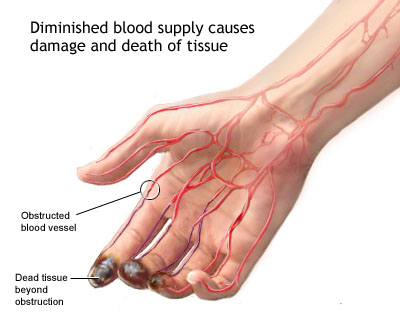Thromboangiitis obliterans
Contents
When to Contact a Medical Professional
Thromboangiitis obliterans is a rare disease in which blood vessels of the hands and feet become blocked.
Thromboangiitis obliterans (Buerger disease) is caused by small blood vessels that become inflamed and swollen. The blood vessels then narrow or become completely blocked by blood clots (thrombosis). Blood vessels of the hands and feet are especially affected. Arteries are more affected than veins. Average age when symptoms begin is around 35. Women and older adults are affected less often.
This condition mostly affects young men ages 20 - 40, who are heavy smokers or chew tobacco. Only 1 of 10 patients are women. Many patients also have very poor dental hygiene, likely due to tobacco use.
This disorder is very uncommon in children. It can occur in children with autoimmune diseases.

Thromboangiitis obliterans is a disorder that leads to obstruction of the blood vessels of the hands and feet. The blood vessels become constricted or totally obstructed because of the inflammation and clots which reduces the availability of blood to the tissues. Thromboangiitis obliterans almost always affects men, 20 to 40 years old, who have a history of smoking or chewing tobacco.
- Fingers or toes can be pale, red, or bluish and feel cold
- Pain in the hands and feet
- Acute, severe
- Burning or tingling
- Often occurring at rest
- May be worse with cold exposure or with emotional stress
- Pain in the legs, ankles, or feet when walking (intermittent claudication), often located in the arch of the foot
- Skin changes or small painful ulcers on fingers or toes
- Usually two or more limbs are affected
The following tests may show blockage of blood vessels in the affected hands or feet:
Special ultrasound of the extremity called plethysmographyy
Doppler ultrasound of the extremity
Blood tests for other causes of inflamed blood vessels (vasculitis) and blocked (occlusion of) blood vessels may be done. These causes include diabetes, scleroderma, and atherosclerosis. In rare cases when the diagnosis is unclear, a biopsy of the blood vessel is done.
There is no cure for thromboangiitis obliterans. The goal of treatment is to control symptoms and to prevent the disease from getting worse.
The patient must stop using tobacco. It is also important to avoid cold temperatures and other conditions that reduce blood flow in the hands and feet.
Applying warmth and exercising gently can help increase circulation.
Aspirin and medications that open the blood vessels (vasodilators) may help. In severe cases, surgery to cut the nerves to the area (surgical sympathectomy) can helpcontrol pain.
If the area becomes so infected that tissue dies, it can be necessary to amputate the fingers or toes.
Symptoms of thromboangiitis obliterans may disappear if the person stops tobacco use. Persons who continue to use tobacco may need repeated amputations of affected fingers or toes.
Tissue death (gangrene)
Amputation of fingers or toes
Loss of blood flow in the limb of the affected fingers or toes
When to Contact a Medical Professional
Call your health care provider if:
- You have symptoms of thromboangiitis obliterans
- You have thromboangiitis obliterans and symptoms get worse, even with treatment
- You develop new symptoms
Prevention
Persons with a history of Raynaud disease or blue, painful fingers or toes, especially with ulcers, should not use any form of tobacco.
Alternative Names
Buerger disease
Source: http://www.nlm.nih.gov/medlineplus/ency/article/000172.htm

